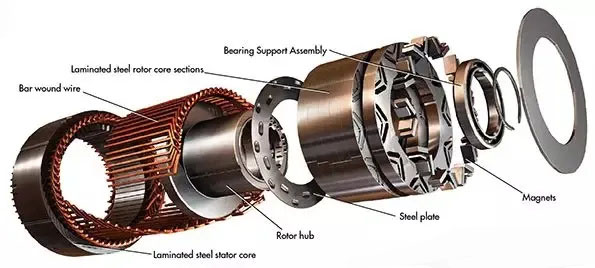Application Status Of Mainstream Insulation Materials In Drive Motors
2024-03-13
As we all know, any live equipment or machine is most afraid of leakage and short circuit.
Today we will discuss the current application status of the main insulation materials used in drive motors of new energy vehicles.
Insulation system
Typical insulation solutions for drive motors today can generally be divided into primary insulation and secondary insulation.
Main insulation is crucial to the safe operation of the motor, including electromagnetic wire insulation, slot insulation, phase insulation, slot wedge insulation, impregnating paint, etc.;
Secondary insulation mainly plays a auxiliary insulation effect and provides mechanical support and protection for the coil, including insulating sleeves, binding ropes, busbar insulation and solder joint coating.
Corona resistant enameled wire
The drive motors are turning faster and faster, and the power density of the electric drive system is getting higher and higher. The performance and quality requirements of enameled wires are bound to become more and more stringent.
Currently, nanoparticle-modified H-class (or above) corona-resistant enameled wires are mainly used in electric vehicle drive motors.
The paint film of this enameled wire developed from the early three-coat layer to the later two-coat layer. Due to the short life of the three-coat layer and the relatively poor adhesion of the paint film, it gradually cannot keep up with the requirements.
In 2000, DuPont developed a two-coat corona-resistant enameled wire. The bottom coating is a nanoparticle-modified polyesterimide corona-resistant coating, and the top coating is a PAI coating.
Since its introduction, the secondary coating has been widely used in the field of drive motors. In recent years, with the rise of oil-cooled motors, PAI single-coated corona-resistant enameled wire has become more and more widely used due to its resistance to ATF oil and high temperature.
We all know that the materials and technologies used are constantly changing according to the technology of the application subject. No material is a panacea.
With the rapid development of flat wire technology, higher slot fill rate and power density have led more and more OEMs to choose flat wire motors.
However, the coating process of the four "R" corners of the corona-resistant enameled rectangular wire is poor. In current applications, pain points such as reduced corona resistance and unstable performance often occur.
In addition, some recent commercial applications are using PEEK materials extruded onto enameled wire instead of solvent-based dip coating.
Insulating impregnated resin
The motor stator insulation treatment mainly uses vacuum impregnation resin (VI) and vacuum pressure impregnation resin (VPI). Generally speaking, the matrix resin is modified polyester or polyester imide with high strength and high heat resistance.
It is worth mentioning that nanoparticle modification technology can improve paint hanging efficiency, heat resistance and corona resistance by adding nano-inorganic particles.
Speaking of the current situation, in recent years, resins adapted to new processes such as winding heating and curing, ultraviolet curing, and rotating dripping have also entered people's field of vision.
Among them, the electric heating process is a new method with high efficiency. It only takes a few minutes from impregnation to resin gel, and the entire process can be completed in about an hour. Moreover, the amount of paint can be precisely controlled, the filling performance is good, and no resin curing waste is produced.
However, the main equipment for the electric heating process is still controlled by foreign companies in Germany and Italy, and the import price is relatively high. There has not yet been a large-scale domestic expansion.
Soft composite materials
At present, the mainstream non-oil-cooled drive motor slot insulation, slot wedge, and interphase insulation mainly use two layers of polyaramid fiber paper (such as Nomex) and a layer of PI film to form a soft composite material.
This insulation material has an H-class heat resistance rating and is cheaper, so it is widely used. However, its corona resistance and ATF oil resistance are slightly worse.
With the popularity of oil-cooled motors, such soft materials that are not resistant to oil begin to fail and are prone to delamination, thereby reducing the insulation performance.
This creates a "vicious cycle": in order to improve oil resistance, single-layer thick polyaramid fiber paper with better oil resistance will be used in motor development and design;
However, the electrical properties of this material are relatively poor. In order to improve the insulation performance, the material design thickness must be increased. Increasing the thickness will inevitably affect the power density, thus increasing the manufacturing cost of the entire motor.
